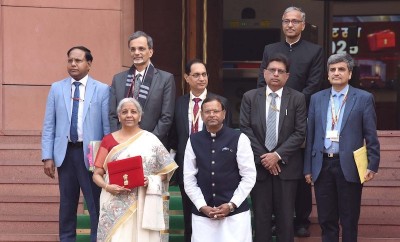 FPI
FPI
Continuous FPI sell-off drives Rs 27,680 crore outflow from Indian equities in November
Mumbai/IBNS: Foreign portfolio investors (FPIs) continued their withdrawal from the Indian stock market on Wednesday, marking the 33rd consecutive day of outflows.
They pulled out an additional Rs 2,502 crore, bringing the total outflow for November to Rs 27,683 crore, according to the latest data from Trendlyne.
This persistent sell-off has intensified pressure on Indian stocks, pushing benchmark indices into correction territory.
Mid- and small-cap stocks have been hit hardest, experiencing more significant declines.
While domestic institutional investors have stepped in to absorb some of the selling pressure, injecting billions into the market, the ongoing FPI outflows continue to drag the market lower.
Despite efforts from local institutions, the market shows signs of continued decline, reflecting the sustained foreign selling.
The reversal of strong FPI inflows into Indian equities, which followed the US Federal Reserve’s aggressive 50 basis point rate cut in September, was swift.
In October, FPIs were net sellers in every session, pulling out a record Rs 1.14 lakh crore from Indian stocks via exchanges.
As a result, both the Nifty 50 and Sensex dropped more than 6 percent, marking their worst monthly performance since March 2020.
The shift in FPI sentiment is largely due to disappointing September quarter earnings, which fell short of expectations and weakened investor confidence in Indian equities.
These results have caused FPIs to reassess Indian stock valuations, which they no longer see as aligned with the country's earnings performance.
As a result, they have redirected investments toward other Asian markets, such as China and Hong Kong, where valuations appear more attractive in comparison to India’s relatively high stock prices.
FPIs have also been drawn to China's recent stimulus measures, hoping that these efforts will help revitalize the country's economy, which has struggled post-pandemic.
What was once a market where investors eagerly bought into dips has now shifted.
Investors are now quick to sell into rallies, with each attempt by major indices to rebound quickly followed by selling, pushing indices to multi-month lows.
In addition to weak Q2 earnings and slowing high-frequency economic indicators, rising retail inflation in October—hitting a 14-month high—has added further pressure on the market.
This increase in inflation has raised concerns that the Reserve Bank of India (RBI) may hold interest rates steady through FY25.
Investor sentiment is also being weighed down by uncertainty over the potential impact of a possible Trump administration in the US on emerging markets.
Inflation is already having an impact on urban India, reducing consumer spending, as seen in the slowdown of FMCG and automobile sales.
Analysts warned that if urban growth continues to falter, it could further hamper both earnings and market performance.
On top of these economic concerns, government spending has slowed due to the national elections, with expenditure from April to June at only about 44 percent of the full-year target.
Analysts believe this weaker spending is contributing to the recent slowdown in India’s high-frequency economic indicators.
As a result of these pressures, the Nifty 50 and Sensex hit a five-month low in the latest trading session, marking a 10 percent correction from their record highs.
Support Our Journalism
We cannot do without you.. your contribution supports unbiased journalism
IBNS is not driven by any ism- not wokeism, not racism, not skewed secularism, not hyper right-wing or left liberal ideals, nor by any hardline religious beliefs or hyper nationalism. We want to serve you good old objective news, as they are. We do not judge or preach. We let people decide for themselves. We only try to present factual and well-sourced news.







